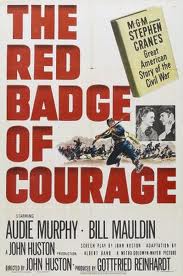
THE RED BADGE OF COURAGE
US, 1951, 69 minutes, Black and white.
Audie Murphy, Bill Mauldin, John Dierkes, Royal Dano, Andy Devine, Arthur Hunnicut.
Directed by John Huston.
The Red Badge of Courage, a minor film in its time and released as the supporting half of a double bill, has become something of a minor classic. Stephen Crane's story of a young innocent in the Civil War is archetypal material for interpreting the American hero. The setting of the Civil War is important - not in the ultra-heroic tradition of Hollywood, the God With The wind scale, but with the preoccupation of the ordinary men, called up without quite knowing why and involved in the horrors of American fighting American. All this is captured realistically and symbolically in the film.
Audie Murphy, the most decorated American soldier from World War Two, had achieved something of a career in the '50s with competent westerns. Here he has a chance to do something different and rises well to the demands. He was to make interesting films like Joseph Mankiewicz The Quiet American and John Huston's The Unforgiven. Commentators have written of the visual poetry of this film. However, there is a long story be hind its production. There were many clashes at M.G.M. at the time, especially amongst executives. There were re-writes of the film and a great deal of editing especially after John Huston, the director. left for Africa to make his next film, the classic The African Queen. Much of this material is covered in John Huston's autobiography; but there is a very well written book about Hollywood and film-making called Picture by Lilian Ross. It focuses completely on the difficulties in the making of The Red Badge of Courage. This book has been set as a school text and is worth study in itself. It provided many insights into the background of the making of this film. There was a telemovie remake in 1974 starring Richard Thomas in the central role with Michael Brandon and Wendell Burton. Direction was by Charles B. Fitzsimons.
1. How enjoyable was this film? As a war film, as a human document, as the filming of a classic?
2. Comment on the modesty of the film's scope and yet its homage to Crane and to American history. Does it deserve to be considered a film classic?
3. The quality of the black and white photography and its atmosphere, the use of music and its heaviness - appropriate? The filming of the strategies of battles compared with the close-ups of the personalities?
4. How successful was the narrative technique? For information, its total effect, as partly distancing the audience from the action, as making demands of the actors to illustrate the commentary? The focus of the book itself? The closing of the book at the end?
5. The importance of Stephen Crane as the author? As a young man of 22 and matching the use of the book?
6. The picture of war: for America, the rebel calling to the youth, the capturing of the rebels? The realities of war, the greatness of war, the uselessness of war, volunteering, training, the desire for action, the patriotic songs for each side, the flag, the fears and running away, the Red Badges of Courage? What insight into the situation of war did the film give?
7. How important for the film was a war in America? The feeling for an American war, American courage, the fact that it was a civil war and not an overseas war?
8. How interesting was the characterisation of the youth? How did he engage audience sympathy? How did the film try to draw our sympathy? His being called The Youth rather than his name predominantly, his age, as a volunteer, as a deep and sensitive young man, yet his fears, his tears, unwilling to admit apprehension? His interaction with the other men? His basic courage and yet the reality of his fear? The effect of the encounters with the wounded? Telling lies, returning? What made his so courageous at the end? His heroism? The need for telling the truth, yet his half-telling the truth? How had he grown and matured by this experience? His experience of life and death? How was he a symbol of America's youth and the basis for its future?
9. What was audience response to the other soldiers? How convincing were they in their realism and their personalities? The hillbilly soldier, his companion, the soldiers sunning away, the Captain, Jim and his death etc.? The General?
10. How were these soldiers symbols for attitudes of persons in war? The tall soldier Jim at his death, the ragged wounded soldiers, the talk amongst themselves, the nature of the fighting and its representation of human feelings and fears, the significance of deaths? The role of the General and his morale boosting, his talk about supper etc.? His prayer in battle?
11. How effective was the filming of the battles? The impact of the reality of war, charges, deaths, bullets and bayonets? Wounds? Its impact in the fighting in America itself, the landscapes, the birds singing after the smoke passed away?
12. What is heroism and what motivates it? Its illustration in this film?
13. The film as a portrayal of humanity? Limited with good and bad yet so real?
14. What are the classic qualities of this film?